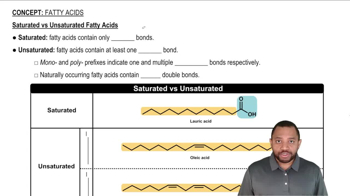Identify each of the following reactions a to e in the β oxidation of palmitic acid, a C16 fatty acid, as
(1) activation
(2) first oxidation
(3) hydration
(4) second oxidation
(5) cleavage
c. Palmitic acid, CoA, and ATP form palmitoyl CoA.
 Verified step by step guidance
Verified step by step guidance Verified video answer for a similar problem:
Verified video answer for a similar problem:


 1:29m
1:29mMaster Oxidation of Fatty Acids Concept 1 with a bite sized video explanation from Jules
Start learning